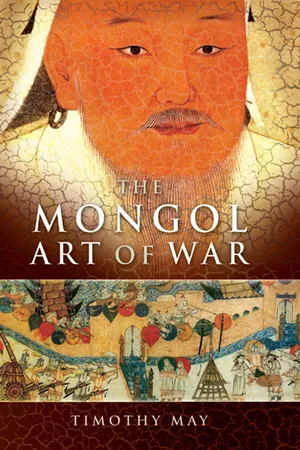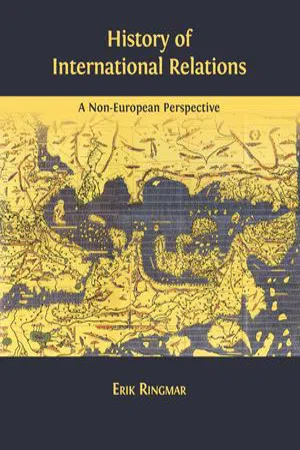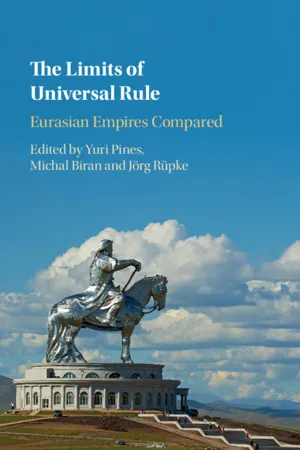History
Genghis Khan
Genghis Khan, born as Temujin, was a Mongol warrior and founder of the Mongol Empire in the 13th century. He is known for his military leadership, strategic brilliance, and the unification of the Mongol tribes. Under his rule, the Mongol Empire became the largest contiguous empire in history, stretching from Eastern Europe to East Asia.
Written by Perlego with AI-assistance
Related key terms
1 of 5
8 Key excerpts on "Genghis Khan"
- eBook - ePub
- Dr. Christopher Gabel(Author)
- 2014(Publication Date)
- Tannenberg Publishing(Publisher)
Chapter 2 — Genghis Khan
by Terry Beckenbaugh, Ph.D.Of all the great commanders in human history, perhaps none rose from more dire straits to greater heights than Genghis Khan. Rising from the poverty of exile, the young boy named Temujin who eventually became Genghis Khan, helped his family survive the harsh steppe climate, grew to a strong and charismatic young man who united the disparate Mongol tribes into a nation, and founded what became the world’s largest contiguous land empire. Yet for all his accomplishments, Genghis Khan is probably the least well known of the great commanders. A significant reason for that is the fact that when Genghis Khan founded the Mongol empire, the Mongols had no written language.The earliest primary sources chronicling the Mongols were the accounts of the peoples the Mongols conquered. Since that conquest tended to be brutal, the portrait of the Mongols that emerges is understandably not flattering. To study the Mongols one must have an extraordinary fluency in a variety of foreign languages. Thus, the scholar can spend a lifetime mastering diverse languages such as Japanese, Korean, Chinese, Vietnamese, Turkish, Russian, Persian, Arabic, Hungarian, German, Latin and Mongolian to study the Mongol conquests. An added handicap for people in the English-speaking world who wish to study the Mongols is that the Mongol conquest never reached the British Isles, nor did significant English-speaking elements serve within the Mongol forces or fight against them. This has the effect of tamping down scholarly inquiry in the English-speaking world, so that the English speaker must have reading comprehension of German and/or Russian to read the best western scholarship available on the Mongol empire.{21} Since very few people have the linguistic ability to truly master the plethora of languages necessary to study the Mongols, those who do overwhelmingly tend to focus on a region the Mongols conquered. This narrows the focus to China, Persia, Arabic-speaking lands of the Middle East and Russia and is much more manageable as a scholarly endeavor.{22} - Prajakti Kalra(Author)
- 2018(Publication Date)
- Routledge(Publisher)
1 Rise of Chinggis KhanBy unifying all the Turko-Mongol nations into a single empire, by imposing iron discipline from China to the Caspian, Jenghiz Khan suppressed the endless intertibal wars and afforded the caravansa security they had never known.1The rise of Chinggis Khan (1206–1227) and his empire in the thirteenth century had its roots in the historical, political and social structure of nomadic peoples of Inner Asia. He exemplified adaptation to the changing pattern of steppe society. His policies were a reaction to the anarchy that had descended on the steppe in the eleventh to twelfth centuries as a result of shifting alliances and weak allegiances. His innovative strategies and charismatic personality put him in a position to attract followers and revitalise the region. His polices and reorganisation of the steppe led to its transformation into a place of functional order and stability which was used as a springboard for uniting the rest of Eurasia. The creation of a supratribal identity associated with the person of Chinggis Khan was passed down to his descendants who expanded the Mongol ideology and applied it beyond the steppe. The politics and society in the steppe at the time of Chinggis’ rise presented him with an environment of chaos and dysfunction which was crucial in determining his policies and their appeal to a majority of the tribes. Members of tribes that willingly chose to ally with him initially were dissatisfied individuals who found themselves on the periphery of existent tribes.2 Chinggis Khan himself was an example of a dissatisfied member of a tribe that had left him and his family in their hour of need. His personal life experiences served as a backdrop for the principles which were to guide him in the governance of his empire. The paramount position of stable allegiances and loyalty remained at the centre of the institutions he created and remained the core of the Mongol state even under his descendants. Chinggis Khan’s legal code (yasaq) and the establishment of the imperial bodyguard (keshig) served as the backbone of a Mongol system which valued elements that maintained functional order on the steppe and beyond. He attracted followers as a result of his military successes and his sense of fair play when it came to the distribution of rewards. He exemplified steppe traditions of generosity and reciprocity3 by promising a share in the spoils of war for his army of conquest, returning favours to all the people who helped him in his struggle against his rivals (for example, he offered support to the Khitan brothers in their fight against the Jurchid for their help against his rival Jamugha) and opening trade routes for merchants.4- eBook - ePub
- Timothy May(Author)
- 2020(Publication Date)
- Pen & Sword Military(Publisher)
Chapter One The rise and expansion of the Mongol Empire, 1185–1265The Mongol Empire founded by Chinggis Khan (also known as Genghis Khan in the West) became the largest contiguous empire in history, stretching from the Sea of Japan to the Mediterranean Sea and the Carpathian Mountains. At its peak, more than a million men were under arms and enrolled in the armies of the Khan, or the emperor of the Mongol Empire. The Mongol Khans became determined to conquer the world, and, indeed, with the resources at their disposal there was little reason why they should fail. Eventually, however, their empire collapsed, partially under its own weight. The following is a brief history of the rise of the Mongol Empire and its subsequent expansion across Asia and into Europe, until it fragmented into four smaller yet still powerful kingdoms.The rise of Chinggis KhanThe most difficult stage in the evolution of the Mongol empire was the unification of Mongolia itself under Chinggis Khan. There was no clear reason why Temüjin, as Chinggis Khan was known, should become the supreme power in the Mongolian steppe. Indeed, there were many more significant leaders and tribes. The Mongols themselves were a broken power, having suffered defeats by their hereditary enemies – the Tatars in eastern Mongolia, and the Jin Dynasty, which ruled Northern China – in the 1160s. The ramifications of these defeats were immense, and resulted in the Mongols declining to the status of a minor power in the steppe, often requiring the support of more powerful tribes to withstand the continued aggression of the Tatars. Nonetheless, although the Mongols were now without a true khan a few clan leaders still maintained the struggle. One such leader was Yisügei Bahadur (bahadur - eBook - PDF
- Erik Ringmar(Author)
- 2019(Publication Date)
- Open Book Publishers(Publisher)
Georgia, a Christian kingdom, was to become a particularly loyal ally. Once the Mongols had established themselves in the Caucasus, in turn, they came into contact with the Kievan Rus, the fledgling Russian state in present-day Ukraine. However, HISTORY OF INTERNATIONAL RELATIONS 106 in 1227 an unexpected uprising among the Tanguts forced Genghis Khan to return home. This is also where he died, aged sixty-five years old, under rather mysterious circumstances. Some say that he was wounded in a battle, others that he fell off his horse, or perhaps that he was killed by a Tangut woman he had taken as a concubine. In any case, his body was buried in a grave without markings according to the customs of his tribe. By the time of his death the Mongols controlled the center of the entire Eurasian landmass — from the Pacific Ocean to the Black Sea. Genghis Khan in today’s Mongolia During the Communist period, 1924–1992, when the Soviet Union exercised a strong influence in the country, textbooks used in Mongolian schools described Genghis Khan as a “reactionary” and an “enemy of the people.” However, in commemoration of the eight hundredth anniversary of his birth in 1962, a monument was erected in his honor and an academic conference was held to discuss his life and legacy. The conference ended with applause, cheers, and chants for Genghis Khan. Agents for the KGB, the Soviet secret service, who were present on the occasion, reported the event to Moscow. This resulted in purges within the leadership of the Mongolian Communist Party. Those who had sided with Genghis Khan were regarded as enemies of the Soviet Union. Since the end of Communism, there has been a strong revival of interest in Genghis Khan in Mongolia and he is now regarded as a national hero. Mongolians are quick to insist that his reputation as a bloodthirsty barbarian is vastly exaggerated. - eBook - ePub
The Mongol Conquests
The Military Operations of Genghis Khan and Sübe'etei
- Carl Fredrik Sverdrup(Author)
- 2022(Publication Date)
- Helion & Company(Publisher)
4 In this section he will be called Temüjin – covering his own campaigns – and Genghis Khan in the second, where the focus is Sübe’etei. In Chinese annals he is referred to as emperor or specifically the first ruler. They view him as the founder of the Yuan dynasty, though it was only his grandson Kublai who set up court in Beijing.Sources: Zhao Hong, in P. Olbricht and E. Pinks, Meng-Ta Pei-Lu und Hei-ta Shih-Lüeh (Wiesbaden: Harrassowitz, 1980), p.12; Rashid al-Din, 437–440; Juvaini, p.143; George Dennis, Maurice’s Strategikon (Pennsylvania: University of Pennsylvania Press, 1984) p.23; Harold Lamb, The Earth Shakers (Garden City, New York: Doubleday and Company Inc., 1949), p.67; Boyle, commentary on Juvaini, p.55; J. F. C. Fuller, The Generalship of Alexander the Great (New Brunswick: Rutgers University Press), p.58; James Chambers, The Devil’s Horsemen, The Mongol Invasion of Europe (London: Cassell, 1988), p.15; Barfield, p.160; Ratchnevsky, Genghis Khan: His Life and Legacy (Oxford: Blackwell, 1991), pp.17–19; Trevor Royle, A Dictionary of Military Quotations (London: Routledge, 1990), p.55.1 See Zhou Qingshu, ‘A critical examination of the year of birth of Chinggis Khan’, in Xin Luo, Chinese Scholars on Inner Asia (Bloomington, Indiana: Indiana University, 2012), pp.331–352.2 Fuller is retelling a Plutarch anecdote.3 See, for example, in the East Roman manual the Strategikon (written c.AD 620).4 This title is perhaps best rendered into English as Genghis Khan. Genghis Khan is used in this book as this form has become the most recognised.Passage contains an image
2
The Officers
Further, Činggis Qa’an said to Qubilai, ‘For me you pressed down the necks of the mighty ones, the buttocks of the strong ones. You, Qubilai, Jelme, Jebe and Sübe’etei – these “four hounds” of mine – when I sent you off, directing you to the place I had in mind, when I said, “Reach there!”, you crushed the stones to be there; when I said, “Attack!”, you split up the rocks, you shattered the shining stones, you cleft the deep waters. When I sent you, Qubilai, Jelme, Jebe and Sübe’etei, my “four hounds”, to the place I had designated, if Bo’orču, Muqali, Boroqul and Čila’un Ba’atur – these “four steeds” of mine – were at my side, and when the day of battle came and I had Jürčedei and Quyildar standing before me with their Uru’ut and Mangqut troops, then my mind was completely at rest. Qubilai, will you not be in charge of all military affairs?’ - R. Abazov(Author)
- 2016(Publication Date)
- Palgrave Macmillan(Publisher)
IV The Mongols and the Decline of Central Asia I n the late twelfth century Central Asia entered an era of general political anarchy. Several Turkic dynasties and clans battled each other to establish control over the various parts of Jetysuu, Maveranahr and Khorasan. Almost every leader was forced to fight off claims and counterclaims to the supreme throne from numerous members of his own clan. The general population was deeply frustrated by rulers and governors who wasted resources on never-ending wars, neglecting public proj- ects such as irrigation, policing and infrastructure. The wars became more frequent and more rancorous, as some commanders began randomly executing not only the commanders of competing armies but also entire clans and families. These actions ignited the flames of blood feuds and internecine wars in the region. In the meantime, in the east a new power began to emerge. The Mongols, a large tribal confederation inhabiting much of Mongolia and southern Siberia, gradually consolidated into a formidable military and political force. Genghis Khan (?–1227), the leader of a minor tribal group, played a significant role in this con- solidation. Through a maze of internal wars he rose from the ranks of outlaw and leader of a renegade band to become one of the most powerful leaders among the tribes. In 1206 many of the Mongols were brought together into a nomadic protostate, and an assembly of the tribal leaders (kurultai) proclaimed Genghis Khan the supreme khan (ruler). What distinguished the Mongols under Genghis Khan’s leadership from their Turkic predecessors was the use of total war against all opponents. They raised the experience of tribal blood vengeance to an unprece- dented mass level. During their numerous campaigns, they did not balk at slaughtering the entire civil popula- tions of rival tribes, cities and towns.- eBook - PDF
The Limits of Universal Rule
Eurasian Empires Compared
- Yuri Pines, Michal Biran, Jörg Rüpke(Authors)
- 2021(Publication Date)
- Cambridge University Press(Publisher)
The Chinggisid ideology of world conquest, in contrast, is very much present in these genres (see Hülegü’ s letter cited above), well into the 14th century. It remained valid even after the Ilkhanate’ s Islamization in 1295, when Islamic formulas were added (Amitai 2013, 37–62, 102–5). 25 Hülegü was actually a grandson of Chinggis Khan, unlike the leaders of his neighbors, the Jochids and Chaghadaids, called after Chinggis Khan’ s sons. 26 Manzi in Chinese refers to the southern barbarians, but in Mongolian meant south China; Nangiyas in Mongolian is derived from the Chinese Nanjia, southern people. 27 Cleaves 1951, 53; 1959, 62; Kim 2015. 247 The Mongol Imperial Space Apparently, the Mongols felt more at home in the universal world of Islam, the leadership of which they could claim after extinguishing the Caliphate, than in the more limited notion of Iran. In other words, while adopting a more complex, glocal world order favored by their subjects, the Mongols still stressed its universal aspects. 6.3 Shaping Future Imperial Space Speaking of Mongol legacy, we may conclude that it was the glocal world, rather than the Chinggisid universalism, that had the biggest impact on the shaping of future Eurasian space. In geopolitical terms, united China, inde- pendent Iran, and Russia as a Eurasian superpower are still with us. In Inner Asia, in distinction, the Mongol period’ s main effect was not creating a new imperial entity but rather a major ethnic reconfiguration (namely affecting people rather than territory). The population movements generated by the conquest and post-conquest policies led to the disappearance of various established steppe people, such as the Kitans, Tanguts, Uighurs, 28 and Qipchaqs, and the emergence of new collectivities, such as the Uzbeks, Kazakhs, and Tatars, who became the modern Central Asian Muslim peoples. - eBook - PDF
The Horde
How the Mongols Changed the World
- Marie Favereau(Author)
- 2021(Publication Date)
- Belknap Press(Publisher)
The begs acknowledged the khan’s primacy because he was a descendent of Chinggis Khan’s eldest son, Jochi. But that status did not make a khan all-powerful. To be elevated on the felt rug—the procedure for enthronement—an aspi- rant had to associate himself with powerful begs. Similarly, to rule ef- fectively, a khan needed the begs on his side. They supported him and, if he failed, deposed him. This was especially the case after the 1350s, during and following a period known as the bulqaq —anarchy. In the INTRODUCTION 13 course of this period, several pretenders to the Jochid throne strug- gled to take and keep power. While they foundered, the locus of au- thority shifted definitively to the begs. They maintained the Horde’s governing traditions, sought to elevate new khans who could rule in the image of Chinggis and his descendants, and pursued power for themselves. 10 No single study has heretofore treated the Horde as a case of effec- tive empire building, but historicizing this specific form of collective power is essential for understanding post-Chinggisid steppe societies and the nomads’ role in Eurasian history. I hope that this book will serve as a model for grasping the impact of nomadic empires on world history—and that the book will help readers rethink the conventional view of empires as invariably sedentary powers. Historically, sedentary powers have indeed erected powerful empires, often dominating nomads in the process. But nomads have also established sovereignty over sed- entary peoples. By capturing the notion of a moveable state, this book offers a new perspective on collective power and on the fascinating shapes it can take. 11 If the Horde were projected on today’s maps, it would stretch across a region occupied by Ukraine, Bulgaria, Moldavia, Azerbaijan, Georgia, Kazakhstan, Uzbekistan, Turkmenistan, and Russia, including Ta- tarstan and Crimea. The history of the Horde is therefore a shared legacy.
Index pages curate the most relevant extracts from our library of academic textbooks. They’ve been created using an in-house natural language model (NLM), each adding context and meaning to key research topics.
![Book cover image for: Great Commanders [Illustrated Edition]](https://img.perlego.com/book-covers/3018137/9781782894469_300_450.webp)






